

Drilling Your Stop Holes
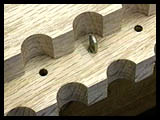 Now that you have these
great templates made you might be itching to take them for a
test spin. We won't disappoint. The next step before you assemble
the jig is to set the stops for your router. Not all of the shelf
holes you drill will make use of the whole jig so you need to
stop the router where you want it.
Now that you have these
great templates made you might be itching to take them for a
test spin. We won't disappoint. The next step before you assemble
the jig is to set the stops for your router. Not all of the shelf
holes you drill will make use of the whole jig so you need to
stop the router where you want it.
The simplest and fastest way for making stops is clamp one template over the other and drill a row of pin holes in each template - a couple shelf pins can then be used to stop your router.
The procedure - set your router on one template with the guide bushing in a dimple; then draw a line around the right side of it's base. Add a 1/4" or so and this is the ideal place to drill a hole. Clamp one template over the other, shifted according to the distance determined by your pencil line, then take your router for a test ride and drill a bunch of holes. Take it easy - it's your first time behind the wheel. ;)
Figuring the Pin Hole Offset
 This next part
is tricky because not everyone will want to use a 13/16"
guide bushing with 3/4" diameter template holes - and you
don't need to. Any combination will work OK as long as the bushing
is slightly larger than the hole you drill in the template. If
you do use my combination for your jig, you'll get approximately
the same numbers as I did. Pay attention please...:)
This next part
is tricky because not everyone will want to use a 13/16"
guide bushing with 3/4" diameter template holes - and you
don't need to. Any combination will work OK as long as the bushing
is slightly larger than the hole you drill in the template. If
you do use my combination for your jig, you'll get approximately
the same numbers as I did. Pay attention please...:)
Using a piece of scrap (the melamine in photo), clamp your fixed rail down and drill a hole with the router. I have a cute little ruler from Bridge City Tools which has markings on the end and it's easy to see the offset for my router from the rip line though the template holess. Mine read 5/32" to the hole center but yours might vary depending on the hardware you're using and how well you ripped the holes in half. If you don't have a ruler with end demarcations, clamp the template exactly one inch from the scrap edge and then measure from the edge to the center of the hole.
Positioning the End Rails to the Templates
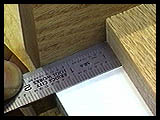 Once the offset is determined,
add to that the distance you want the holes from the edge of
your workpiece. I wanted my holes 1 3/8" from the edge so
I butted the end of the fixed template to the inside face of
an end rail with a total offset of 1 17/32" (1 3/8"
+ 5/32").
Once the offset is determined,
add to that the distance you want the holes from the edge of
your workpiece. I wanted my holes 1 3/8" from the edge so
I butted the end of the fixed template to the inside face of
an end rail with a total offset of 1 17/32" (1 3/8"
+ 5/32").
In addition to this offset is the distance I want the end rail to hang down below the templates to hook the ends of my panel. This hang down is what you use to align your workpieces when mounting the jig - I chose 1/2". It was easy to mark by slipping a piece of 1/2" scrap under the template.
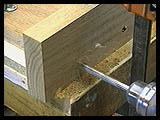 With the joint
position of the end rail and fixed template figured out, locate
the position of your lags. I drilled the 5/16" pilot holes
in the end rail and then used it as a drill guide for going into
the end of the template. Space your holes at least 1/2"
from the edges of the template and center them up and down in
the 3/4" template stock. Clamp the parts in place and then
drill. (Photo right)
With the joint
position of the end rail and fixed template figured out, locate
the position of your lags. I drilled the 5/16" pilot holes
in the end rail and then used it as a drill guide for going into
the end of the template. Space your holes at least 1/2"
from the edges of the template and center them up and down in
the 3/4" template stock. Clamp the parts in place and then
drill. (Photo right)
After the pilot holes are drilled in both ends of the fixed template, drill another set into the adjustable template. It should have the same hole spacing but instead, the bolt shanks slide back and forth in a 3/8" groove cut in the end rail pieces.
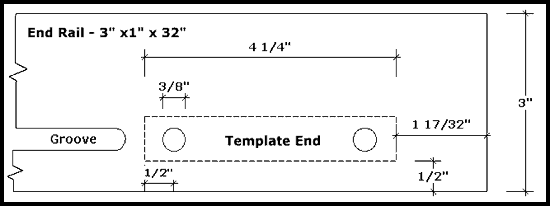
How long you make this groove depends on how wide a panel you plan to work with. How you make the groove is up to you - whatever feels safest! I used an edge guide on my plunge router. Again, precision isn't needed nor will it affect the action of this jig. If you really want easy alignment when using this jig, make sure your end rails are dead flat so when you tighten the lags down, the jig is naturally square.
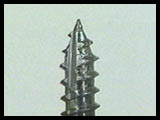 Before assembling
your jig with the 8 lag bolts, you need to ream out the 5/16"
pilot holes in the end rails to 3/8". Otherwise you'll split
the oak when you try to tighten the lags.
Before assembling
your jig with the 8 lag bolts, you need to ream out the 5/16"
pilot holes in the end rails to 3/8". Otherwise you'll split
the oak when you try to tighten the lags.
Another method to avoid splitting the holes in the template ends uses a modified lag bolt to tap the holes and actually cut threads into the oak. Take one of your lags and file a rabbet into the end across the threads. In effect you're creating teeth to cut matching threads in the oak. Run this lag into each of the 8 pilot holes in the template ends before you assemble the jig and you'll eliminate any chance you'll split the oak when tightening the lags down.
The first time the jig was used on a scrap panel, many problems arose. For those experiences and how they were fixed, this article is concluded on the next page.